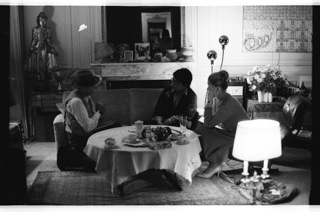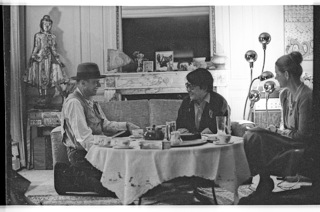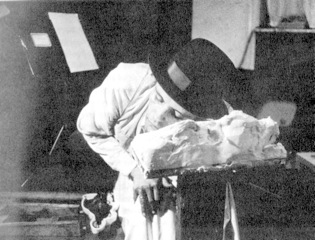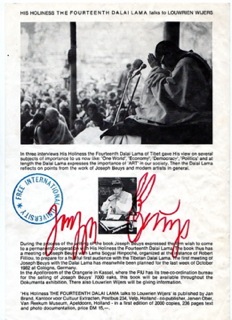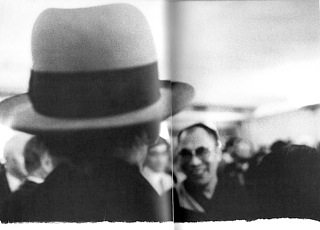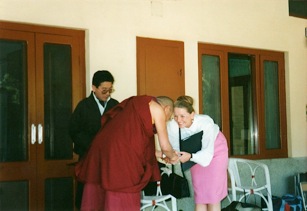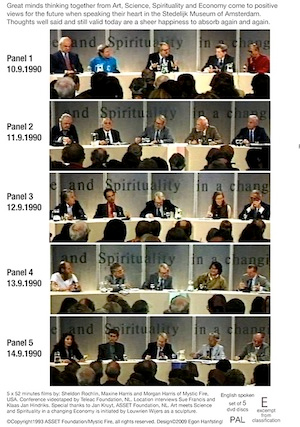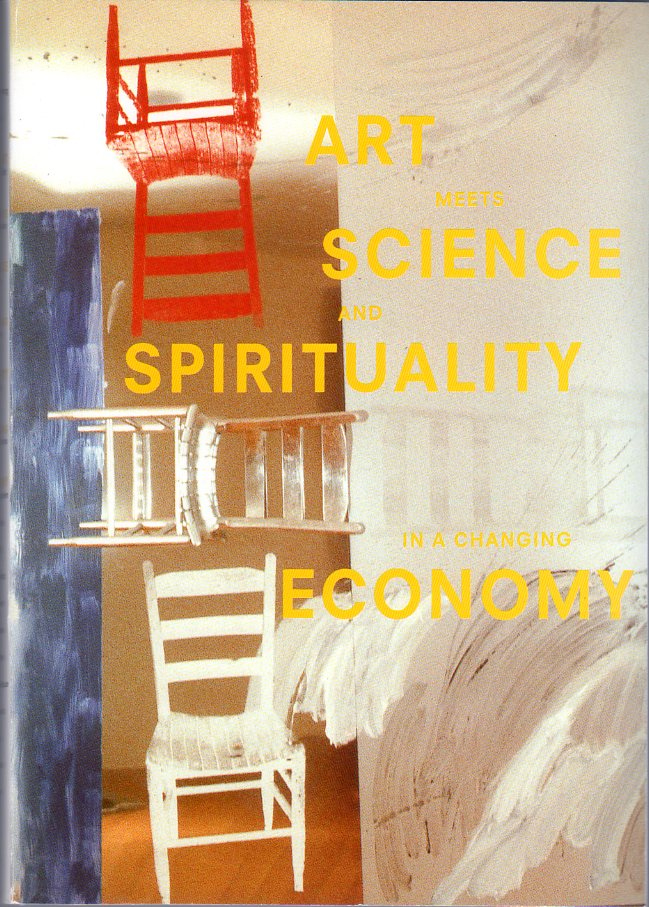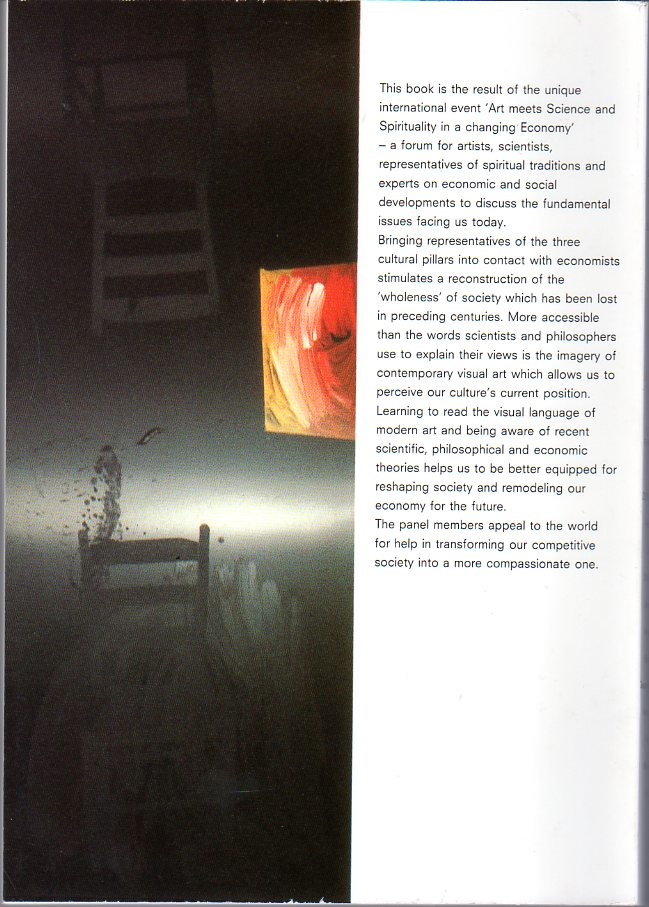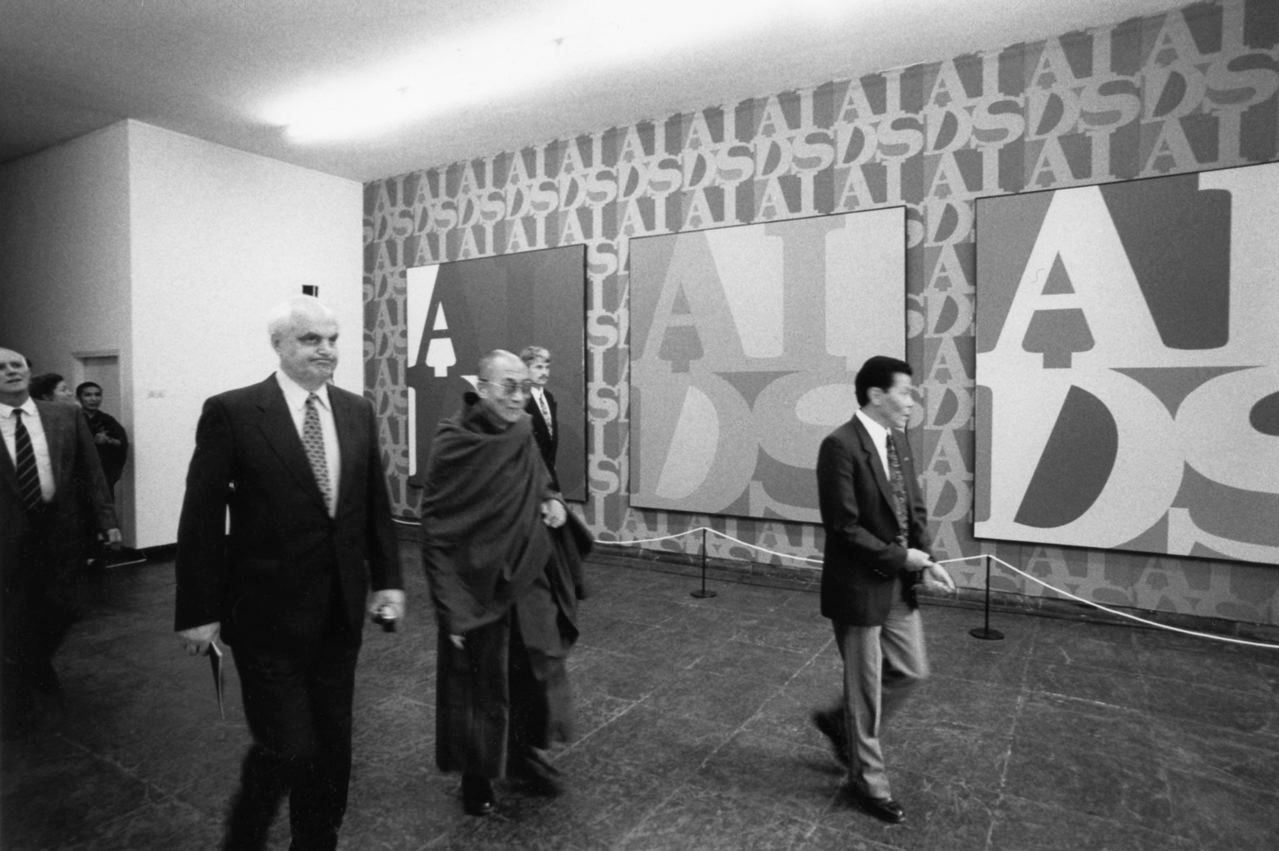Venerable Tenzin Peljor requested me to print my interview on art with HH the Dalai Lama on his web site and write an introduction with it. Here comes the introduction.
Introduction
In 1977 my close friend, the Dutch/French artist Ben d’Armagnac, told me to dig up my old typewriter and work with it again. From 1960 to 1969 I had used my typewriter every day for my writings, but from 1969 onward I had not touched the typewriter at all, because I felt I was now a sculptor. All those years from ’69 to ’77 I worked with metal to make metal sculptures. I had to think. What could I do with my typewriter? The terms ‘Writing as Sculpture’ and ‘Mental Sculpture’ came up. How was I to do that? Then I felt I would really like to have an in-depth interview with the German artist Joseph Beuys who I had known since 1968 about his art. I did the first interview in September 1978 and more followed in 1979.
When the book Joseph Beuys talks to Louwrien Wijers was out in 1980 Joseph Beuys asked me to go with the same questions to Andy Warhol, who was his good friend at the time. Beuys told me Warhol would be in Geneva in June 1980. Could I please go there and talk to him at length? It became the longest interview Andy Warhol ever did in his life, I heard later on. At the end of that interview Andy Warhol said: “On the way up I was reading the biography of your Dutch Queen Juliana, what a wonderful person she is.” I said: “Indeed she is very wonderful.” And I added: “On the way to here I read the autobiography of the Dalai Lama.” “Oh,” Andy Warhol replied: “You must ask the Dalai Lama these questions. I have just published an interview with the Dalai Lama in my magazine Interview. He is a great person.” Back in Amsterdam I sent a letter to the Office of HH the Dalai Lama in Dharamsala, India, and within ten days I had a letter back saying: “Come.”
At the end of our interview the Dalai Lama said: “If you have more time maybe we should speak again.” Two days later I had my next interview appointment. When I reached back home, I phoned Joseph Beuys and he said: “Louwrien I want to make a permanent cooperation with the Dalai Lama and you have to bring us together. With the Dalai Lama we can really make Eurasia happen.” When I told French Fluxus artist Robert Filliou about Beuys’ plan with the Dalai Lama Robert said: “I will tell my teacher Lama Sogyal Rinpoche about this.” Immediately Sogyal Rinpoche suggested that it would be a good idea to inform Joseph Beuys about Tibetan Buddhism, before he was to meet the Dalai Lama. In January 1982 I brought Joseph Beuys together with Lama Sogyal in Paris. Their interview is in the ‘blue book’.
Then Lama Sogyal told me to go back to Dharamsala to inform HH the Dalai Lama about the work of the Joseph Beuys. In April 1982 I sat again next to the Dalai Lama and showed him the first book in English on the work of Joseph Beuys. HH the Dalai Lama turned the pages thoughtfully and halfway through said: “The work of this artist is about impermanence,” and he softly closed the big coffee table book. Indeed, Joseph Beuys was always fascinated by the fact that all things change all the time. He was the first artist to use fat for his sculptures, that would melt when he put his warm cheek against it.
From the meeting in Bonn grew the idea to make ‘Art meets Science and Spirituality in a changing Economy’ where artists, scientists, spiritual leaders and economists would meet for five days. Joseph Beuys was enthusiastic, Robert Filliou was happy and gave me instructions how to start the big event, Andy Warhol was looking forward to be with HH the Dalai Lama. But while preparing, within 1986 and 1987, Beuys, Warhol and Filliou died. In 1990 the American artist Robert Rauschenberg, who had brought his work to Tibet as early as 1985, filled in for Joseph Beuys in Panel 1 with HH the Dalai Lama. It was HH the Dalai Lama himself who asked me in the Mayor’s house in Amsterdam: “And where is the museum with the art works?” “It is very near Your Holiness,” I said. “Then let’s go,” HH the Dalai Lama answered and took me by the arm, over the sidewalks along the Herengracht and Vijzelstraat to the Fodor Museum on the Keizersgracht. All who were at the Mayor’s reception followed. It was the very first time for HH the Dalai Lama to be in a museum of modern art. There are photos that show how much HH the Dalai Lama enjoyed looking at contemporary art.
Louwrien Wijers, 17 September 2013


Exploring modern art: HH the Dalai Lama reflects on points from the work of Joseph Beuys
For the realization of Joseph Beuys’ vision to prepare a permanent conference on the questions of humanity with His Holiness the Dalai Lama, it seemed necessary to convey more details to the Dalai Lama beforehand. Encouraged by Lama Sogyal Rinpoché, who had advised me to inform His Holiness about the issues that Joseph Beuys works on, a third audience with the Fourteenth Dalai Lama was requested upon my return to Dharamsala in the spring of 1982.
The Private Office of His Holiness the Dalai Lama allowed that third interview on Monday the 12th of April 1982, from half past one until a quarter to three in the afternoon, and, as before, it was held at the Thekchen Choeling palace of the Dalai Lama in McLeod Ganj, Upper Dharamsala. At first only Ngari Rinpoché, the younger brother Tenzin Choegyal of the Dalai Lama, who serves His Holiness as His special secretary, was present at the audience. Later professor Jeffrey Hopkins of the University of Virginia, U.S.A., was called in to assist at the translation.
This time a list of six questions had been prepared and handed in at the Private Office a few days prior to the audience. Three questions were referring to means that Joseph Beuys, and modern art in general, have worked with in the recent past. The last three questions were meant to bring up points on which eventually a co-operation between His Holiness the Fourteenth Dalai Lama and Joseph Beuys, representing the Free International University, might be based if a mutual interest proved to be practicable.

From the beginning the work of Joseph Beuys has shown us his interest in the ancient cultures of the Eurasian continent, and looking back at his oeuvre we can already discern some early connections with Tibet too. Several pieces refer to Genghis Khan, the Mongolian nomad leader who conquered large parts of Asia and Europe in the thirteenth century. The biography of Joseph Beuys lists: 1929 Exhibition at the grave of Genghis Khan, 1958 Watercolour of Genghis Khan’s daughter riding on an elk, I960 Watercolour of Genghis Khan’s daughter. The relationship that the Tibetans have with Genghis Khan is that in 1207 they sent an official delegation to him and his Mongol horde to establish friendly relations. Later the grandson of Genghis Khan became the student of the great Tibetan Lama of Sakya monastery.
A drawing of 1954 by Joseph Beuys has the title: ‘In the house of the Shaman’, and this most probably refers to the Tartars who in 1943 found Joseph Beuys in the wilderness of the Crimea, caught in the wreckage of his crashed airplane. The Mongolian shamanistic Tartars cared for the wounded war-pilot for eight days. His impressions of the nomads had an everlasting effect on the 22-year old Joseph Beuys. From 1963 on many of the actions that Joseph Beuys then starts to perform, clearly show his deep involvement in the cultural heritage of Central Asia. In 1963 and 1966 Joseph Beuys has executed the actions ‘Siberian Symphony, 1st Movement’ and ‘34th Movement of the Siberian Symphony’. And the film ‘Trans-Siberian Railway’ was already conceived in 1961. In 1966 and 1967 he did the actions ‘Eurasia’ and ‘Traekvogn Eurasia’. And in 1967 and 1968 he performed the actions ‘Eurasianstaff 82 min. fluxorum organum’ and ‘Image Head - Mover Head (Eurasianstaff) Parallel Process 2’, in which the actual Eurasianstaff was the symbol of a future unity of East and West. The staff was here drawn on the floor, and ran from East to West, doubling back towards the East. In this way the staff was a conductor of energies linking the Eastern capacity for transcendental thought with Western materialism, the idea being that if the two abilities were firmly united the split between intuition and reason would be overcome.
Many of the drawings that Joseph Beuys has done show figures that pass freely from one level of existence to another, herewith representing the reincarnation principle of Eastern philosophy, that is often fervently rejected by modern Western thought. Thus Joseph Beuys has throughout his career joined East and West in the primordial source of his thinking, his actions, his drawings and his sculptures. Not only Joseph Beuys, but also many other modern artists have in the recent past in actions, happenings and performances worked with the meditative, ritualistic aspect that some spectators have referred to as ‘shamanistic’. This again seems to be a link with Tibet, the country where shamanism remained intact until the destructive Chinese invasion. To this remark Joseph Beuys has said: “When I appear a shamanistic figure, then I do this to stress my belief in other priorities. The idea of shamanism is a reminder of a human constant without which we would be drastically impoverished. The Shaman brings about development. His nature is therapeutic. While Shamanism marks a point in the past, it also indicates a possibility for historical change and development. I realize the part the artist can play in indicating the traumas of a time and initiating a healing process. That relates to what people call shamanistic.”
The question concerning this meditative, ritualistic aspect in the work of Joseph Beuys, and in the work of a certain number of Western modern artists involved in the performance-art of the last two decades, was brought to the attention of His Holiness the Fourteenth Dalai Lama in the following manor:
Q: Could Your Holiness remark on a way in which ‘shamanism’, that has
been well kept in Tibet, could work in our present times, or is working
in our present times?
Dalai Lama: When you say ‘shamanism’, which one..? Bön po.. or..?
Louwrien Wijers: That I can’t say.. I can only refer to a meditative, ritualistic
aspect that we believe ‘shamanism’ has, and that has been represented
in modern art performances.. The audiences of such events have called
such attitudes of the artists ‘shamanistic’..
(Here His Holiness the Dalai Lama interrupts and puts a question to
Ngari Rinpoché, who then asks me if it would be alright if Professor
Hopkins comes to help with the translation. I welcome the proposal
and meanwhile His Holiness continues:)
Dalai Lama: ‘Shamanism’, I don’t know.. I do not know the demarcation,
or exact meaning, of ‘shamanism’.. Some people with ‘shamanism’ refer
to Bön po.. Bönism.. the ancient Tibetan religion..
L.W.: That is what they do refer to here also, I think..
(Professor Hopkins enters the room and the Dalai Lama asks him in
English: ‘Shamanism, is it mainly referring to Bönism?’ Jeffrey Hopkins
answers in Tibetan and a conversation develops in Tibetan. Then the
Dalai Lama asks me:)
Dalai Lama: When you say ‘shamanism’ what is your definition?
L.W.: My definition is ‘ritualistic, meditative events’.. in this case
done by modern artists.. That is the reference where I am coming from..
Dalai Lama: Now repeat your question..
L.W.: Could Your Holiness remark on a way in which ‘shamanism’, that
has been well kept in Tibet, could work in our present times, or is
working in our present times?
(Professor Jeffrey Hopkins again speaks in Tibetan with His Holiness the Dalai Lama and then asks me:)
Jeffrey Hopkins: The problem is that this is an unfamiliar word in Tibetan.. There is no direct translation for the word..
L.W.: The minds of the people go to Tibet, when they say ‘shamanism’..
Jeffrey Hopkins: Yes..
L.W.: ..or Mongolia..
Jeffrey Hopkins: Yes.. or some Indian tribes in South America.. ancient peoples.. the ancient cultures.. But exactly what is ‘shamanism’..? If you could say that, then perhaps we could think about it..
L.W.: Yes.. All that I can refer to is, that the ritualistic aspect is about feeding the audience and having a therapeutic relief on the audience..
Jeffrey Hopkins: Hmm.. Isn’t all religion like that?
L.W.: This is modern art.. The question comes from modern art..
Jeffrey Hopkins: Modern art.. So the painting has..
L.W.: Performances.. we’re talking about performances..
Jeffrey Hopkins: Drama..?
L.W.: No..
(Here His Holiness the Dalai Lama starts to laugh and says:)
Dalai Lama: Ha.. ha.. ha.. ha.. it’s a subject in itself.. ha.. ha..
L.W.: I’m sorry to create such confusion..
Jeffrey Hopkins: So it is like a ritual performance..
L.W.: That’s right.. done by visual artists..
Jeffrey Hopkins: ..and it has an effect like medicine on the audience..
L.W.: Yes.. to initiate a healing process.. (His Holiness the Dalai Lama speaks in Tibetan to Professor Hopkins, who then translates:)
Dalai Lama: The pleasure and pain that the mental-consciousness experiences is mainly influenced by the experience of the eye-consciousness, the ear-consciousness and so forth.. Thus the colours and shapes of figures doing certain things, and the sounds of music and so forth, can have a profound effect on the experience of pleasure and pain by the mental-consciousness.. And in terms of dharma for instance, even if the meaning is the same, there will be various tunes, or melodies, through which is chanted, and there will be then a different impact.. (His Holiness adds in English:) Similarly.. this thing which we can see through pictures, or certain drawings.. from that again there is some impact on the sixth mind, or the main -, or mental-consciousness.. The religious rituals have a connection in this way.. On that basis a certain religious, ritual aspect happened.. Because of that reason.. Now again, I think, once your sixth -, or mental-consciousness.. the main mind.. once it develops further.. then, I think, the mental consciousness’ dependency on other sense consciousnesses is less and less.. So, you see, the other day I mentioned.. I think you may have noticed.. (Here His Holiness refers to the Maha Mudra teachings He gave in Dharamsala a month earlier, where I was present.) Once you reach a certain stage, then the physical action, such as prostration.. or the verbal recitation.. all these things are deliberately stopped, because at a certain stage.. you have to fully develop the mental-consciousness.. (His Holiness continues in Tibetan and Jeffrey Hopkins translates:) Once the practice that is done in terms of the mental-consciousness is fully developed.. once its potency has fully come out.. then one deliberately.. purposely.. stops these other activities that involve the sense consciousnesses..
(His Holiness in English:) Then, at that time, there is no need for the artist.. ha.. ha.. ha.. ha..
L.W.: Wonderful..
Dalai Lama: So now, the main point is.. In order to develop a certain inner progress the artist’s thing is very much influential and helpful. I mean, helpful as well as harmful.. It depends on the meaning that the artist is conveying.. Now, you see, certain art is made to have an impact on hatred, or anger, such things.. and that is harmful.. In any way, the artists with their art, and with this ritual thing, have
powerful means to give a message..
I am not sure I have understood your question entirely, but as far as
I can understand it, this is my response.. ha.. ha..
L.W.: The next question is also complicated I am afraid..
Dalai Lama: Ha.. ha.. ha..

Another connection that Joseph Beuys unintentionally has with Tibet can be derived from the use of butter and fat in his sculptures and actions ever since 1952. Well known are the ‘Fat corners’, the ‘Fat sculptures’, the ‘Fat chair’, and the ‘Fat room’ of the Darmstadt action ‘Mainstream’, in 1967, where Joseph Beuys had a whitewashed room with a bare brown floor lined along its walls with butter. In many different ways were fat and butter applied in his actions, like in ‘The Chief’, in ‘Land beneath’, in ‘Manresa’, in ‘Hauptstrom’ and in ‘Eurasianstaff’, where Joseph Beuys at the beginning kneaded margarine on a cabinet and then smoothed it onto a ladder standing in a corner, and later kneaded margarine into the bend of his knee. The action ‘Vacuum - Mass’ had fat corners and iron boxes each filled with 100 kg fat. In this way Joseph Beuys has worked with fat and butter throughout the fifties, sixties and seventies. An art-critic in this respect pointed at the Indo-European mythology of fat and butter, and recalled that Tibet has always had a veneration of butter and celebrated it with an annual butter feast.
By using fat and butter Joseph Beuys meant to emphasize the importance of transformation. In the same way modern visual artists have worked with different other materials that indicated transformation, over the last decades.
Joseph Beuys has explained his use of fat and butter as follows: “Fat can appear in solid or liquid form according to the temperature. Fat indicates change, transformation. It is the transformation of substance that is my concern in art. If creativity relates to transformation, then creativity is the problem of the future. My idea is to stress the transformation of substance, and substance for me includes all evolutionary power.” At another instance he has said: “I attempted to deal with the heat concept in sculpture. It was already clear to me in 1952 that it would be extremely interesting to bring this to expression in sculpture. Through this process man was brought to a thought discipline which would stimulate his own activity so greatly that it would become a liberating process, that is, he would find himself independent from God.. The fact that he must find these connections on a higher plane after he has been, so to speak, liberated, is very clear.. Had I expressed this in recognizable, logical statements in a book, it would not have been succesful, because modern man is inclined only to satisfy his intellect. It was not up to me to address logic. The beginning of the new always takes place in chaos.” Redirecting the use of materials and ability into socially constructive purposes Joseph Beuys then comes to his famous statement ‘Everybody is an artist’ and sees every person as contributing to the ‘Social Sculpture’ that he considers the main art-work to be accomplished. For this aim thought and speech are then also taken as sculptural means. Joseph Beuys explains: “Only the human capacity for thought can bring new causes into the world and these determine the future cause of history.” From 1973 on lecturing activities take Joseph Beuys across Europe and to the U.S.A. Here he uses his voices as a sculptural means and states: “The voice is a vital transmitter of energy and a direct means in the sculpturing of thinking forms.” Counting on the input of every person’s creativity for the realization of the ‘Social Sculpture’ he says: “It is through people that ideas move forward. Transformation must first take place in the potential of thought and mind. After the deep rooted transformation of the mind power and will power has taken place, evolution can take place.” This concern of Joseph Beuys and of many more modern artists was introduced to His Holiness the Fourteenth Dalai Lama in the following formulation:
Q: Could Your Holiness indicate how transformation works from the
tantric point of view with creativity, and how it then relates to
the power of thought and the power of will?
L.W.: The artists have been concerned with the fact that one has to
transform one’s thought and will to come to evolution.. and they have
used changeable substances in order to show that transformation is of
the utmost importance..
Jeffrey Hopkins: You are saying that the artists purposely use things
like fat and butter, because they change easily..?
L.W.: That’s right..
Jeffrey Hopkins: I see.. Do they make various objects out of fat and
butter, you mean.. in the West..?
L.W.: Not really wonderful objects.. They just use the material to
show that at a certain point it melts..
Jeffrey Hopkins: So that the audience sees that it changes..?
L.W.: That’s right..
Jeffrey Hopkins: In order to emphasize the importance of internal
change..
L.W.: That is right..
(Here His Holiness the Dalai Lama starts discussing in Tibetan with
Professor Hopkins, who then asks:)
Jeffrey Hopkins: So you are wondering about the creative use of the
mind for transformation in the dharma.. Were you asking that?
L.W.: No.. I was asking about the creative use of the mind for the
transformation of the power of will and thought..
Jeffrey Hopkins: Hmm..
(His Holiness the Dalai Lama starts to answer in Tibetan and Professor
Hopkins translates:)
Dalai Lama: Essential is that we have to consider what the definition of will and thought firstly.. When we consider thought from the
point of view of being the opposite of a thoughtless state, then
it seems to be a state of conceptuality.. So, if we consider thought
in this way, as conceptuality, there certainly is transformation of
conceptuality into a non-conceptual state..
L.W.: Yes..
Dalai Lama: Will.. or determination.. transform through thought..
Also thought itself undergoes a great deal of transformation.. that
from which all transformation of thought comes, is the mental -, or
main consciousness.. the continuum of the clear and knowing nature
of the mind.. the luminous and knowing nature of the mind.. Then,
within that which brings about the transformation, there certainly
is thought causing transformation..
(His Holiness continues in English:) Now, from the practitioner’s
viewpoint the transformation takes place in order to get a better
mind.. a better mind and a more subtle mind.. In common sense every
minute, every hour, the main consciousness is transforming.. In order
to guide the transformation of the main consciousness.. (Here His
Holiness stops and shifts to Tibetan. Jeffrey Hopkins translates:)
Transformation comes in the mind through changes in thought itself..
and also through changes of the body, through the strength and
weakness of the body..
(His Holiness here starts to laugh and asks:) Ha.. ha.. ha.. I don’t
know what is your main question..?
L.W.: Yes, ehm.. the main question is that artists wanted to emphasize
that we cannot reach a more developped stage in our situation, and in
our lives, if we don’t transform our minds.. our thoughts..
(The Dalai Lama says in Tibetan that is translated:)
Dalai Lama: As you have been saying this I have been thinking that
there are.. I have heard of, two ways of doing paintings.. One is
that a person thinks beforehand in thought of what the painting will be.. and then paints it out.. And that would be like the thought
approach.. But then there is another one, where the person does
not think about it beforehand, but just spontaneously does whatever
seems appropriate.. And that would be a thoughtless approach, even
throwing paint onto the canvas and so forth, but a work of art
coming out..
L.W.: Is it difficult..? Is this a difficult question?
(Professor Hopkins starts speaking in Tibetan and then asks me:)
Jeffrey Hopkins: Were you just saying that it is the artist’s view,
that if the life is to be changed, first one must change one’s
thought?
L.W.: Yes.. One’s thought and one’s will.. And in this case we
should always think of an artist working for an audience.. there
are people around him.. he is working directly with his audience
and he is trying to express: ‘Understand me, you first have to
transform your thoughts, before we can make a new world..’ Like
that..
(The Dalai Lama answers in Tibetan and Professor Hopkins translates:)
Dalai Lama: There is no question.. there is no doubt about that..
There is no question that no matter who it is.. it is on the basis
of the tamed mind.. a disciplined, trained mind.. that it’s possible,
for instance with art, to produce great art.. And so it is with everything..
It seems that with the artist, first there is the inner feeling and
the thought, and then there is the expression of this in an artistic
way.. whereas for the audience there is first the reception of this
expression and then a change in thought..
(In English the Dalai Lama adds to this:) I think I have said in the
previous meeting how important the task of the artist is in society..
particularly to strive for a less aggressive, more peaceful, more
gentle humanity..
L.W.: I think that is what the artists are hoping to be able to do..
Dalai Lama: Hmm.. Particularly for those people whose consciousness is always going outside.. They have either no time, or no ability, to think inward.. in the inner world.. Always.. (His Holiness shifts to Tibetan that is translated:) It is particularly helpful for those people whose minds are always being directed outwards, because then they need, with this art outwards, to turn themselves inward.. (His Holiness continues in English:) But a certain person who he himself.. or she herself.. is developed in meditation.. such a person can internally create his or her own art.. Then there is no need for external art..
L.W.: Yes.. It seems the artist’s work is the step before meditation.. he hopes to stimulate that.. Or, at least certain artists do..
Dalai Lama: Hmm..

For his lecturing activities, from 1973 on, across Europe and to the U.S.A., called the ‘Energy Plan for Western Man’, it was the aim of Joseph Beuys to extend the notion of sculpture to that of the ‘Social Sculpture’, to ultimately appeal for a regeneration of thinking, and to make his statement of faith in humankind’s ability to emerge from the current crisis, brought about as a result of positivist, materialist and mechanistic thinking in the West, and to evolve a stage further.
The ‘Energy Plan’ took its impulse from Joseph Beuys’ belief that the human being is fundamentally a spiritual being, and that our vision of the world must be extended to encompass all the invisible energies with which we have lost contact, or from which we have become alienated. In the same year 1973 His Holiness the Dalai Lama of Tibet visited Europe for the first time and gave numerous talks on the subject of ‘Universal Responsibility’ saying: ‘Today we all are facing a number of serious problems such as the energy crisis, pollution and overpopulation.. Many of our troubles are manmade, created by our own ignorance, greed and irresponsible action. Many difficulties arise from ideological or even religious conflict, and men fight each other for means or methods, losing sight of their human ends and goals. I feel that our problems, though grave and complex, are within our own power to control and rectify.. Universal Responsibility is based on an understanding of the desire, the right and the possibility of achieving happiness for all beings’.
From as early as 1947 on bees have appeared in the work of Joseph Beuys and later beeswax and honey too appeared. Famous is the piece ‘Honeypump’ at the sixth Dokumenta in Kassel, in 1977, that symbolizes the working principle of the Free International University, founded by Joseph Beuys in 1972. The involvement is not specifically in bees, beeswax, or honey, but in the complex relationships between natural structures as described by Rudolf Steiner in his nine lectures ‘On Bees’ in 1923. Joseph Beuys says: ‘Bees are for me symbols of socialism. This does not mean mechanistic state socialism, but a socialist organism in which all parts function as a living body. A unity which has to function perfectly in a humane, warm way through the principles of co-operation and brotherhood’.
On His historic first visit to North America, in 1979, the Dalai Lama repeatedly said in His lectures: ‘To solve problems we need a warm atmosphere. My mission is, wherever I am, to express my feeling about the importance of kindness and a true sense of brotherhood’. For the seventh Dokumenta in Kassel, now in 1982, Joseph Beuys is planting 7000 oak trees as his contribution to the modern art exhibit. The 7000 oaks are a plea to the community to pay attention to the deforestation that is being executed around Kassel at present.
The Dalai Lama also remarked during his visit to the U.S.A. and Canada in 1979 and 1980: ‘No one knows what will happen in a few decades, or a few centuries. What adverse effect for example deforestation might have on the weather, the soil, the rain. We are having problems because people are concentrating on their selfish interests, on making money, and are not thinking of the community as a whole’.
Like all his oeuvre Joseph Beuys also dedicates this ecological work of art, the 7000 oaks, to the ‘Victory of Socialist warmth and self-determination over materialist greed and alientation’. And not only he, but many modern artists have brought the problem of ecology to the attention of society through their art. To His Holiness the Dalai Lama the question on this aspect of modern art was:
Q: Could Your Holiness suggest how artists can successfully help to overcome present-day materialist greed?
L.W.: Deforestation, I think, is materialist greed.. and to use up all our resources of minerals can be seen as materialist greed.. (The Dalai Lama asks a question in Tibetan that Professor Hopkins translates:)
Dalai Lama: Is the planting of the 7000 oaks an example of something that artists are doing to stop greed..?
L.W.: Yes it is..
Jeffrey Hopkins: And you’re wondering what other examples His Holiness might think of?
L.W.: Or.. not examples, but how our attitude could be towards the problem, how we can make ourselves look at it in a right way..
and then maybe do something about it in the right way..
(Here Ngari Rinpoché, the younger brother of the Dalai Lama, starts explaining in Tibetan to help His Holiness understand the subject. The Dalai Lama has meanwhile taken on his lap the large catalogue of the retrospective Joseph Beuys exhibition at the Guggenheim Museum in New York, winter 1979/1980, that Joseph Beuys – at the instigation of Lama Sogyal Rinpoché – had asked me to present to the Dalai Lama.
Slowly His Holiness leafs through the big book, written and compiled by Caroline Tisdall for this spectacular exhibition that aroused the interest of the New York art-audience. While turning the pages His Holiness the Dalai Lama remarks:)
Dalai Lama: There are many pictures of waste lands and destruction
in here.. In our mandalas there are parts that depict cemeteries to
remind us of impermanence, death and so forth.. And the same is true
when one sees these pictures of waste lands.. and of broken things
and so forth.. You realize that, no matter what articles, or whatever
impermanent thing it is, eventually it comes to a state like this..
And it serves as a reminder..
(When His Holiness has reached the section in the book with the photos
of Joseph Beuys’ Coyote-action in New York, in 1974, He stops turning
the pages, starts giving a long comment in Tibetan and eventually He
closes the book while speaking. Professor Hopkins translates:)
In terms of techniques for causing people who do not have satisfaction,
to generate the essence of satisfaction.. this can be done from the
positive side and from the negative side.. From the negative side is,
to consider the deterioration that happens to everything in time.. And
on the postive side, to consider just what kind of things are finally
achieved through proceeding only in a materialistic way.. what is the
fruit, what is the essence.. what can be achieved.. In other words,
to see the limit of what can be achieved..
For instance for a person who likes money, they should think: ‘Can
money be used to eat.. can you put it on a plate and eat it?’ Or:
‘Can you make clothing out of money?’ When you look right at the thing
itself, it is not so much..
The social art that I like the best is for instance pictures of rich
people, who are in the midst of great anxiety, worrying about their
money and so forth.. breathing heavily, and gasping.. This in contrast
with, like a middle class family that is living just in an adequate
way, without such worries.. and which is a family that is living
peacefully, friendly and contently.. Very beautifully..
The rich person was thinking to become happy through money, but has forgotten about that.. Otherwise I don’t know how artists can teach persons to have contentment.. When artists themselves become greedy, then of course it is very difficult.. ha.. ha.. ha.. ha.. to express contentment.. ha.. ha.. ha..

Here ends the part with questions on some ways of expression in the modern art of our times that have evolved in the work of Joseph Beuys in particular and in the work of a certain number of other artists in general over the past years. The next three questions bring up the subjects ‘economy’, ‘education’, and ‘politics’ on which Joseph Beuys has grounded his revolutionary ideas for the realization of his art work the ‘Social Sculpture’. These subjects might provide a basis for a practical co-operation of Joseph Beuys with His Holiness the Dalai Lama of Tibet, if his actual meeting with the Dalai Lama results in an accord.
On ‘economy’ Joseph Beuys has stated during his meeting with Lama Sogyal Rinpoché in Paris: ‘Economy is not only a money making principle. Economy is principally a way of production to fulfil the demands of the people all over the world.. Here the idea of democracy plays a very important role. Here democracy works with economy.. The most important law for economy is: You must not care for yourself, you must care for other people. And other people have to care for you..’ On ‘money’ Joseph Beuys has stated at another instant: ‘Money should no longer be taken as an economic value, but as a democratic document of rights. The ability of the people is the true capital. The concept of freedom should transform the structure of society and determine the democratic, legal and social means of production. The concept of property should be neutralized, thus eliminating the accumulation of production as property and as an instrument of power. Production should fall in with the needs of the consumers. When profit and property no longer exist stock-markets, speculation, inflation and unemployment will vanish. Now money has become an autonomously functioning system in the realm of laws and contractual entitlement, because Karl Marx accepted the bourgeois description of money. He could not foresee how Capitalism would transform into the power of multinationals and into eppressive domination of the state’.
To symbolize his attitude towards the Marxist ideology Joseph Beuys swept up the Karl Marx Platz in East Berlin on May Day 1972. The new Way in which he wants to handle economy he calls ‘an alternative for both the Western private capitalistic system and the Eastern state capitalistic system’.
At the meeting with Lama Sogyal in Paris Joseph Beuys also remarked: ‘Humankind’s creativity is the capital and there is the organic unity of art and economy’.
To His Holiness the Fourteenth Dalai Lama this subject was formulated in the following question:
Q: Does Your Holiness feel it is appropriate to strive for a new
economic order, and could Your Holiness then relate to the idea in
which money is no longer connected to an economic gold-value, but
becomes a democratic bill of human rights?
(His Holiness the Dalai Lama immediately says in Tibetan and Professor
Hopkins translates:)
Dalai Lama: It is true that the development of an economy is not just
by way of money, but is mainly by way of ability.. (His Holiness adds
in English:) That’s true.. I think, that’s true.. It seems, you see,
that in an open society the individual people can demonstrate their own ability.. As a result we see more initiative.. And nowadays, you
see, in communistic countries.. though there is very much emphasis on
economic development.. but somehow they are too much centralized..
And so, you see, the individual ability and the individual initiative
become difficult to demonstrate.. So, the result is, that despite the
capital, the money, they somehow decline..
(His Holiness asks Professor Hopkins something in Tibetan, in which He uses the words ‘democratic’ and ‘consumers’. Jeffrey Hopkins
translates:)
Jeffrey Hopkins: You were speaking about consumers.. What was the
point?
L.W.: The point is that production..
Dalai Lama: No.. we have another sentence here.. You should work for
others should not..
L.W.: Then others will work for you.. You should care for others, you
should not care for yourself.. then other people will care for you..
That is the basic law of economy.. Then production will fall in with
the needs of people..
Dalai Lama: Very perfect.. So, what is the question..?
L.W.: Could Your Holiness relate to the idea where money is changed,
and is no longer an oppressive power connected to gold-value, but
becomes a democratic bill of human rights..?
Jeffrey Hopkins: Money becomes a bill of human rights..?
L.W.: Yes.. We will work for rights, not for money.. Already people
are experimenting with this in an enterprise model in Germany.. there
the wages are not paid in money, but as rights to meet the physical
needs and the education that one needs to receive..
(Here Ngari Rinpoché gives an extensive explanation to help His Holiness
understand the subject. Then His Holiness remarks in Tibetan that
Professor Hopkins translates:)
Dalai Lama: I don’t know.. The system is complicated.. (His Holiness
continues in English:) No, I mean, the monetary system is complicated..
The economy and money.. the money business.. is complicated.. Not
making money, but the whole subject is complicated.. With the value
of the dollar.. (His Holiness shifts to Tibetan and Professor Hopkins
translates:) The subject of the relationship between the international
monetary situation and all economies is extremely complicated. Nobody seems to understand it.. (His Holiness adds in English:) Nobody knows,
and I don’t know..
L.W.: One can try maybe to design another system, but it is hard to
say if it will work.. is that what His Holiness means to convey..?
(Ngari Rinpoché explains this interpretation further to His Holiness
the Dalai Lama, who then answers:)
Dalai Lama: No, no, no.. I mean, I cannot say.. I do not know much..
(In Tibetan that is translated His Holiness adds:) It is an extremely
difficult topic, therefore it is difficult for me to say anything
about it.. This sort of a question needs to be answered by someone
who has great expertise in monetary matters..
(Then His Holiness speaks for a while in Tibetan and Ngari Rinpoché
gives short answers from time to time. Finally Professor Hopkins
translates:)
It sounds as if it is difficult if you were exchanging articles, like
food for clothing and clothing for food.. in a modern society, this
might be difficult to do.. but I don’t know.. (His Holiness continues
in English:) In any way, you see, the modern society is such.. it is
so industrialized and economies are heavily dependent on each other..
as I always say.. from continent to continent, and from nation to
nation.. So, for that reason the money system is so very complicated
that, I think, something is needed.. (His Holiness continues in Tibetan
that is translated:) What seems strange is the persons who buy and
sell merely money on the world market and that causes.. (His Holiness
takes over in English:) Actually, in his own hand is nothing.. but
somehow it causes big effects.. on the London Market, the New York
Market, the Tokyo – and Hong Kong Market.. It is a very complicated
thing, where people are making profit, but where people are also
undergoing great losses.. For such a question I am the wrong person
to ask..
L.W.: I’m sorry.. All we hope to be able to do is to make the oppression of money, that is so heavy on the shoulders of many people, less by bringing more moral duty back into society, so that people can be freed from that oppression and breathe freely.. That is mainly the idea behind this new way of working with money..
Dalai Lama: The point, I think, is quite clear.. This is really an excellent thought.. When human society becomes a monetary society, that is extremely wrong.. So, to return it to the human society is wonderful.. That is a very good idea.. This something that those who are monetary experts should really think about.. (Laughing wholeheartedly His Holiness adds in Tibetan alternated by English:) Ha.. ha.. ha.. Perhaps it would be good if all of us became beggars.. then we could start all over again.. ha.. ha.. You see, if you have no money, then we can discuss the subject.. but at the moment some people possess so much money.. they won’t think about it.. ha.. ha.. So, we need a revolution.. ha.. ha.. ha..

In I960 Joseph Beuys was appointed Professor of Sculpture at the Academy of Art in the German industrial city Düsseldorf. Instead of the usual four to twenty students Professor Beuys had fifty or more students in his class, and could obtain admission for those students who were denied each year because of the school’s strict rules for application. In October 1972 though the Minister of Education suddenly terminated the contract of Professor Beuys, whereupon two hundred students marched to the Ministry of Education in protest. A large solidarity action for Professor Beuys began in Düsseldorf, and from all over the world numerous personalities wrote protest letters to the Minister of Education/Joseph Beuys took the case to court and finally his dismissal was declared illegal by the Supreme Court. Meanwhile though Joseph Beuys had founded the Free International University, together with the German author Heinrich Böll. In the principles drawn up for the F.I.U. they stated: ‘Creativity is not limited to people practising one of the traditional forms of art. Each one of us has a creative potential which is hidden. To recognize, explore, and develop this potential is the task of the school’. They then promised that the Free International University would stress the ‘values of life’ and the ‘consciousness of solidarity’.
His Holiness the Fourteenth Dalai Lama has in the past years often publicly formulated the wish: ‘Maybe we can find some new type of educational system with an emphasis on love, peace, and brotherhood’. When after the law-suit his professorship at the Düsseldorf Academy of Art was given back to Joseph Beuys, he just accepted his classroom in the building again, and installed the Free International University there.
To His Holiness the Dalai Lama the question on this subject was worded in the following way:
Q: Does Your Holiness feel that for the development of new educational
systems, initiatives in the West like the Free International University,
could make joint efforts with educational developments as practised
at the dharma schools and dharma universities under Tibetan guidance?
Dalai Lama: What do you mean when you say ‘Free’..?
L.W.: The Free International University was called ‘Free’ mainly
because it is not under the law of the state..
Dalai Lama: Private..?
L.W.: One might say private, but the intention was to be free from
any out-of-date oppression.. Free International University..
Dalai Lama: It is very difficult to be ‘Free’ from money.. in our
money-system.. ha.. ha.. ha..
L.W.: Yes..
Dalai Lama: Salaries and these things.. ha.. ha.. ha..
L.W.: That is true, yes..
Dalai Lama: Okay.. Repeat the question..
L.W.: Does Your Holiness feel that for the development of new educational
systems, initiatives in the West, like the Free International University,
could make joint efforts with educational developments at dharma schools and dharma universities under Tibetan guidance?
(His Holiness answers in Tibetan that is translated:)
Dalai Lama: I don’t think that one necessarily needs to make a connection with the dharma.. but it does seem to be true that the educational system must change.. (His Holiness continues in English:) I feel, you see, that the present educational system may not be adequate.. I think, I can put it this way.. The present, general Western, or modern, education.. Now, the modern education is mainly the Western educational system.. I think, generally speaking, that present education-system is invented.. or developed.. in the previous century.. At least, it is not a recent development.. So, you see, during that period the economical condition and the political condition were different.. and generally speaking people were quite.. economically or materially they were not yet developed.. And one was nation to nation more or less independent really.. Now, that condition has completely changed.. So now, according to present circumstances, as you put it, solidarity is very important.. As I always express the oneness of all mankind.. the sameness of mankind.. we all are a member of One Human Family.. Now, the situation itself.. the condition itself.. compels us to go on that line.. Each nation cannot remain truly independent.. Whether one likes it or not one has to deal with the other, including one’s own enemy..
Politically the Western nations remain as one block.. and the Soviet Union and so forth, the Eastern Block, remains as one block.. and to each other they have a hostile attitude.. But in the economy field they have to deal with each other.. So, you see, the emphasis on each child’s mind should be to no more think: Our Nation.. Or: ‘His Nation’.. But: ‘Our World’.. Like that..
L.W.: Yes..
Dalai Lama: I think, you see, that at least in some places, or some
countries.. which are materially highly developed.. one is now beginning to start to realize that the material development alone is not sufficient for humanity.. I think, in the previous generation a general thinker may not have realized that.. When people remain hungry they feel that the food is everything.. So, you see, when a country is not yet fully developed materially, then people feel that material development is the most important thing.. Once you get that, then all suffering.. all problems.. will cease.. will stop.. Now, at present.. the actual experience is now coming.. You have everything, yet you have no peace of mind.. and as a result, despite your good family background.. a good future in the material sense.. you lost interest in that line, and you are searching in other things..
And also, you see, one is spending billions and billions of money in making weapons, trying to conquer the enemy.. But the enemy is also not sleeping.. so, from the other side they are also trying, trying, trying.. The result is that billions and billions of money are in a certain sense wasted money..
So, sometimes I feel, you see, for the U.S. and the Western powers with their nuclear weapons.. their basic problem is that these nuclear weapons are being made to be shot at people.. at the same mankind.. That is not right.. The enemy is the same mankind.. that mankind is the same mankind, who can talk, who can discuss.. who can share love and compassion.. If you work in a proper way then that so-called enemy, instead of harming you, he may be very helpful.. As a human to an animal such as a tiger and a lion.. then there is no other alternative, you have to prepare yourself with a weapon.. because there is no room to discuss with a tiger.. In order to meet a tiger you have to do something.. But here, you see, man to man.. woman to woman.. you can live together.. you can discuss, you can answer each other.. (His Holiness continues in Tibetan that Professor Hopkins translates:) When you identify the other person only as an enemy..
even like an inert stone, unable to hear, or think, anything.. or to
have any discussion.. then the only possibility that appears to your
mind is to destroy that other person.. And that is terrible..
(His Holiness shifts to English again:)
So now, you see.. the main point is.. Because the present condition,
or situation, has changed.. a new pattern for the education-system
should be developed.. for the right way of development of the small
child’s mind.. That is very necessary, and very interesting.. That is
what I feel..
We have not necessarily to make a dharma education.. Dharma means,
you see, a particular religion.. You have to accept the God-theory,
or the karmic theory, or something like that.. That is complicated..
and very difficult, I feel..
L.W.: But could the Western people who want to transform education
just learn from the systems that are being used in dharma institutes
for education..?
Dalai Lama: If we were going to use dharma.. first we would have to
then debate and argue with each other about which dharma to use.. ha.. ha.. ha.. ha.. That is a different philosophy and a different method..
L.W.: That would be too difficult..
Dalai Lama: But, you see, the principle, or the essence of dharma..
I believe.. at least I believe.. the common message, that can be
shared.. that is something related with humanity, not necessarily with
religion.. Whether we call something dharma or not.. that common thing
related with humanity, that is the essence of dharma.. that is the
common thing in every religion..
L.W.: I thought, an institute like the Free International University
might be helped when they would know how dharma schools work.. Without
becoming a Buddhist University themselves, they might learn from the
educational systems used by Tibetan dharma universities..
Dalai Lama: The Free International University, is it only an idea.. or is it already working..?
L.W.: It is already existing.. There are in different countries branches of the Free International University.. and this month, on Thursday the 29th of April, Lama Sogyal Rinpoché from London comes to the Free International University in Düsseldorf, where Joseph Beuys himself is, to show to fifty or more people the video tapes of the ‘Good Heart’ teaching and the teaching on the ‘Training of the Mind’, that Your Holiness gave in London last summer.. Lama Sogyal will show the tapes in the Academy of Art in Düsseldorf, where the Free International University is established..
Dalai Lama: I see..

The political involvement that Joseph Beuys had always carried out, took shape for the first time in 1967 when he founded the ‘German Student Party’, which was sparked off by the shooting of a student in Berlin. At that occasion a students’ magazine in Germany wrote the prophecy: ‘Prof. J. Beuys is the spiritual centre of a ‘cosmopolitan’ view of the world that embraces ideal humanistic ideas and will become a political force in Düsseldorf and in all of Europe’. After 1967 Joseph Beuys was active in numerous political projects and activities. In 1979 finally he and the Free International University were co-founders of the ecological ‘Green Movement’ and in 1980 the political party ‘The Greens’ was founded as the political wing of the ‘Green Movement’ in order to have a legal status in the federal and provincial governments of the country.
During the 1980 election campaign of the Green Party for the Federal Government also the famous artist Andy Warhol from New York gave his support by supplying posters that were seen all over Germany saying: ‘Andy Warhol is for the Greens..’
The main statement that Joseph Beuys ever made on politics is his promise that ‘he will change politics into art’. The Green Party that was established for this reason is successful throughout Germany. The Greens have by now representatives in all the Provincial Governments and they are expected to certainly reach the German Federal Government during the next federal elections.
In everything that Joseph Beuys has undertaken he has always
emphasized: ‘My fundamental aim is to effect change in our social-political system..’
The question put to His Holiness the Fourteenth Dalai Lama on the
issue of politics was phrased as follows:
Q: Which is the dharma advice that Your Holiness considers most
important for people going into politics and aiming at a social -
political change?
Dalai Lama: Invent a big slogan.. ha.. ha.. ha.. Make many promises..
ha.. ha.. ha.. and after you get power you will find some point to
excuse yourself.. ha.. ha.. ha.. ha.. Make thousands of promises..
and a big slogan.. ha.. ha.. ha.. and you get a big number of voters..
But this is only very temporarily beneficial.. Actually many political
parties are doing that.. whether deliberately or not.. that is now
almost the system.. So, that is why people lose trust in political
parties, and in politics..
So, you see, new politics must be truthful and sincere.. But at the
beginning you may not get sufficient votes.. This is what I feel..
Otherwise I don’t know..
To be truthful is very important.. You see, time goes.. If you tell
a lie.. sooner or later the people will realize: That person is a
liar.. You see, there may be some gain through telling a lie, but it
is a very temporary gain.. very temporary.. So, be truthful and
straightforward.. Otherwise I don’t know..
L.W.: This was my last question..
Dalai Lama: Finished now..?
L.W.: Yes Your Holiness..
Dalai Lama: Very good.. Very complicated questions.. ha.. ha.. ha..
L.W.: I am very sorry..
Dalai Lama: Anything else..?
L.W.: No, this is all Your Holiness..
Dalai Lama: Thank you..
L.W.: Thank you very much..
Thekchen Choeling, Residence of the Dalai Lama,
McLeod Ganj, Dharamsala, District Kangra, India,
12th of April 1982.

Typewriter from East Germany
My typewriter from East Germany came into my life when I had started to type out my artist’s books myself. Performance artist Ben d’Armagnac had told me in 1977 to pick up my old typewriter again after almost a decade of not having worked on it at all. I needed to find out what a sculptor can do with a typewriter. At first I made interviews with performance artists, typed out exactly what they said and the typed out pages were handed out to the audience before the start of that artist’s performance. During the performance I made notes from minute to minute of what the performance artist did. The notes I typed out too and also copies of those were made available to everyone who turned up for a series of performances. If you collected all my typed out pages you had a complete eye-witness report.
Then long interviews that could fill one book took over. That is 1979. My typewriter specialists, where I went if I needed help, worked from a grand white house in a park, a father and his son. Whenever I came they were successful in repairing or advising what to do. One day the father, already in his eighties, said to me: “I have something very special for you.” He went downstairs and came back with an East German typewriter in a grey case. The type was developed by an institute for the visually impaired in East Berlin, he explained, and was for very many easy to read. I was amazed. Look here how very elegant the design of this type is:
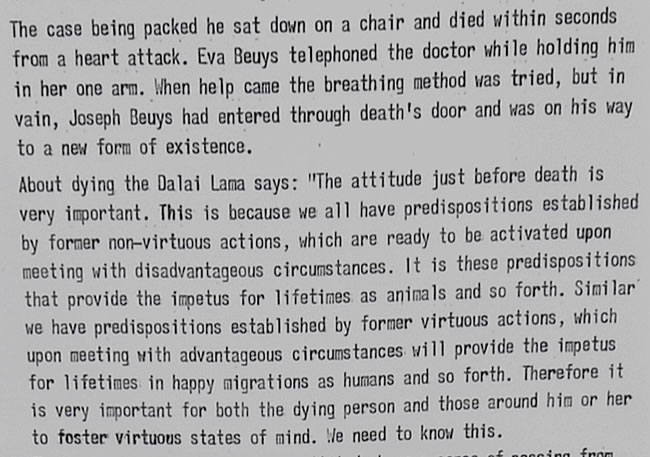
I was unbelievably happy with my East German typewriter. From that moment onward I made all my work on that typewriter. I called the work ‘Writing as Sculpture’. As a follower of Joseph Beuys, like him I understood ‘writing as sculpture’ and ‘speaking as sculpture’. Beuys used to say: “As I speak the sculpture drills itself into your ears.” I loved that.
My book typing stopped when around 1987 I felt like changing from ‘Writing as Sculpture’ to ‘Mental Sculpture’ in order to be able to sculpt multi-layered matters into the mental consciousness of my audience. I wanted to clarify complicated ways of thinking from different points of view to show that a new view, a new paradigm, more appropriate in our times than the worn out mechanistic world view, was ready for us to be adopted. My Mental Sculpture Art meets Science and Spirituality in a changing Economy of 1990, five days of panel meetings of artists, scientists, spiritual leaders and economists in the Stedelijk Museum in Amsterdam, received worldwide coverage, film reports were shown on television in 52 countries and in 1999 Art meets Science and Spirituality in a changing Economy was chosen one of the fifty most important initiatives of the last millennium. All the while my East German typewriter waited for me, almost forgotten because film and computers had taken over. But the great typewriter from East Germany is still standing next to my desk today, ready to do duty again.
LOUWRIEN WIJERS
Copyrights
© Louwrien Wijers
A collection of publications and texts conceived by the artist.
Courtesy of the artist
www.louwrienwijers.nl
▶ Buy the ‘Blue Book’
Publisher
The interview “HH the Dalai Lama reflects on points from the work of Joseph Beuys” was published in “His Holiness the Fourteenth Dalai Lama of Tibet talks to Louwrien Wijers”, Kantoor voor Cultur Extracten, Holland, June 1982, pp.102–128.
Further Readings
- Writing as Sculpture 1978–1987 – Louwrien Wijers (1996); Academy Edition
- The Artists Role – Interview with Dzongzar Khyentse Rinpoche
- Natural Vitality – A stimulating talk on art & practice by Dzigar Kongtrul Rinpoche
- felt – Fluxus, Joseph Beuys, and the Dalai Lama – Chris Thompson; University of Minnesota Press: 2011.
- Smile of the Buddha – Eastern Philosophy and Western Art from Monet to Today by
Jacquelynn Baas (Author), Robert Thurman (Foreword); University of California Press: 2005.
- Smile of the Buddha explores the influences of Asian world-views and particularly Buddhism on the art of Europe and America in the modern era. It describes with great care all the artists influenced by Buddhism throughout the last more than 120 years:
- THE INFINITE MOMENT
Claude Monet, 1840–1926
Vincent van Gogh, 1853–1890
Paul Gauguin, 1848–1903
Odilon Redon, 1840–1916 - OTHER DIMENSIONS
Wassily Kandinsky, 1866–1944
Constantin Brancusi, 1876–1957
Marcel Duchamp, 1887–1968
Georgia O’Keeffe, 1887–1986 - THE SPACE OF ART
Isamu Noguchi, 1904–1988
Ad Reinhardt, 1913–1967
Yves Klein, 1928–1962
Jasper Johns, 1930– - THE SOUND OF THE MIND
John Cage, 1912–1992
Nam June Paik, 1932–
Yoko Ono, 1933–
Laurie Anderson, 1947– - LIGHT AND INSIGHT
Agnes Martin, 1912–
Robert Irwin, 1928–
Vija Celmins, 1938–
Richard Tuttle, 1941–
- THE INFINITE MOMENT
- Smile of the Buddha explores the influences of Asian world-views and particularly Buddhism on the art of Europe and America in the modern era. It describes with great care all the artists influenced by Buddhism throughout the last more than 120 years:

HH the Fourteenth Dalai Lama exploring contemporary art
HH the Dalai Lama in the Fodor Museum, Amsterdam, 1990, passing a work by artists group General Idea from Toronto. Next to HH the Dalai Lama you see Russian economist Prof. Stanislav Menshikov.

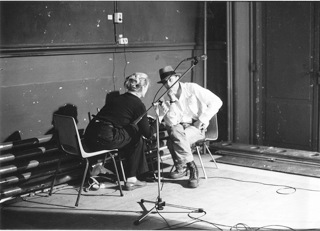
Joseph Beuys with Louwrien Wijers, 1978
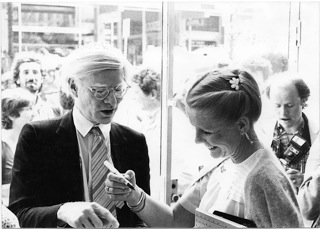
Andy Warhol with Louwrien Wijers, 1980

Interview book of 1982 with HH the Dalai Lama by Louwrien Wijers
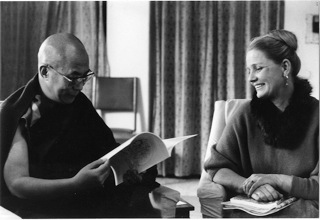
HH the Dalai Lama with Louwrien Wijers, 1982
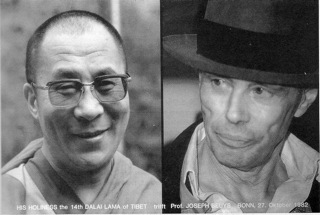
Book on the meeting of HH the Dalai Lama with Joseph Beuys, 27 October 1982 in Bonn.
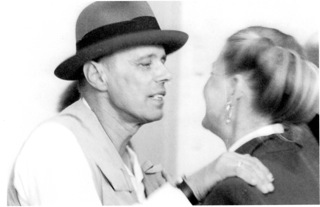
Joseph Beuys and Louwrien Wijers, 1982
